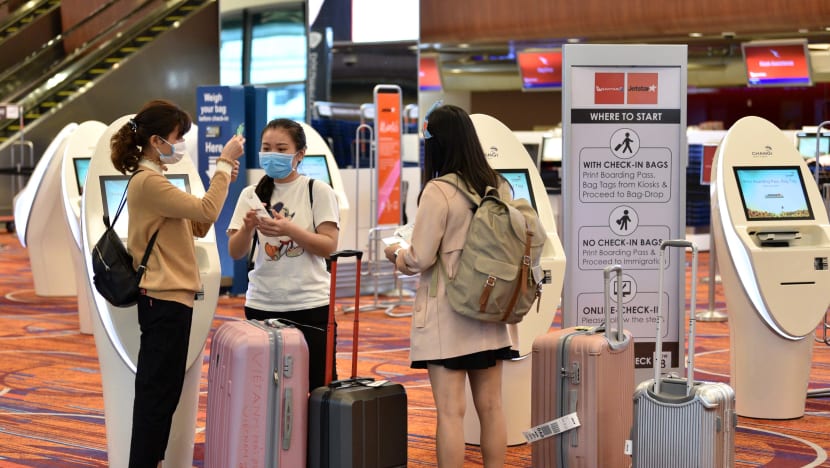commentary Commentary
Commentary: Bitter truths for Singapore Airlines about this aviation industry crash
There’s no escaping the need for a healthy balance sheet, diversifying revenue sources and rethinking frequent fleet renewal, says Nitin Pangarkar.

A Singapore Airlines plane sits on the tarmac at Singapore's Changi Airport on Mar 11, 2020. (Photo: Reuters/Edgar Su)
SINGAPORE: Among the casualties of the COVID-19 pandemic are millions of individuals who stand at risk of losing their livelihoods and industries on the precipice of the biggest disruption ever.
The airline industry is among the most severely affected and is close to being snuffed out after travel bans and restrictions imposed by several governments around the world.
In a book I co-authored more than a decade ago on Singapore Airlines, I and my co-authors argued that “managing the uncontrollables” was a key challenge for airlines.
In other words, airlines have to deal with circumstances such wars or epidemics like SARS and COVID-19, and hence must have large slack resources such as cash to protect themselves from adverse events.
Even then, none of us surely could have imagined the scenario facing modern aviation.
AN EXEMPLARY PERFORMER
During its first 40 years, SIA was an exemplary performer. From 1972 to 2011, it had one loss-making year, whereas the average airline lost money every third year, and many airlines even more frequently.
READ: Commentary: COVID-19, the biggest crisis ever for Singapore’s aviation industry and Singapore Airlines
READ: Commentary: The brewing concern over jobs and salaries as COVID-19 persists
Though SIA’s financial performance has been patchier since 2011, it has continued to be profitable - until this year.
COVID-19 and its fallout are posing a challenge like no other. SIA has reduced capacity by 96 per cent and grounded almost all of its fleet.
As Ven Sreenivasan pointed out in his recent analysis in the Straits Times, much of SIA’s costs are fixed, taking a heavy toll on its cash position, even when no flights are being operated.
SIA has already announced it will bolster its capital, at rather unfavourable terms to current shareholders. The Singapore Government, like others around the world, is also offering assistance in terms of reduced or deferred fees and wage offsets, among others.

Even a venerable company like SIA, which has historically taken pride in being profitable and self-sustaining, was not spared the blushes by the current crisis.
Assuming that a situation with implications similar in severity to the COVID-19 pandemic might occur in the future, SIA can protect against a repeat scenario by following three key strategies.
MAINTAIN A STRONG BALANCE SHEET
In a recent commentary, Bloomberg opinion columnist David Fickling argued even an airline with an extremely strong balance sheet would not be able to survive the fallout of the COVID-19 crisis without help from its financial backers including governments or big name shareholders.
READ: Commentary: The world’s airlines are headed for a crash landing. Government parachutes need to be activated now
READ: Commentary: The problem with reusing the 2009 global financial crisis playbook to deal with COVID-19
While it is difficult for any airline to keep billions of dollars in cash for a contingency, ensuring enough cash reserves and a strong balance sheet is surely a more robust and prudent strategy for an airline that could face many future crises and other rainy days, instead of banking on the goodwill of its backers.
In the good old days, SIA used to have very little debt, but that is no longer true - it has four outstanding bonds totalling S$1.3 billion, one of which matures next year. Yet premium airlines like SIA choose to splurge on somewhat unnecessarily aggressive plans on fleet renewal.
DIVERSIFY THE GEOGRAPHICAL BASE OF REVENUE SOURCES
Though COVID-19 has spread around the world, its intensity varies across geographic locations and many countries still allow some air travel activities.

Many other crises in the past tended to be geographically focused. Whenever Singapore is affected, the impact on SIA tend to be large because of its single-hub strategy. While SIA is trying to build Vistara in India, it remains a work in progress.
The uncertainty surrounding that joint venture, which has seen heavy-handed regulation and shifting policies, including delayed approvals from India for international flights, will not go away anytime soon.
In the medium- and long-term, SIA may be well served by looking for opportunities to have bases outside Singapore.
LISTEN: COVID-19 and safe distancing – why this can save lives
READ: Commentary: COVID-19 outbreak has become an existential crisis for the cruise industry
While past attempts to build these bases, through the purchase of Virgin Atlantic and a stake in Air New Zealand, have met with limited success, going forward, there may be more of such opportunities, which could also prove more attractive if the airline industry undergoes consolidation after battling the coronavirus downturn.
LOWER DEPENDENCE ON PREMIUM TRAVELLERS
Most premium airlines derive a good proportion of their revenues and a larger proportion of their profits from premium passengers. In fact, strategies such as fleet renewal and new customer conveniences are primarily directed at earning the loyalty of these passengers.

The COVID-19 pandemic might bring about a big change in the travel habits of premium passengers, most of whom travel for work. Having been forced to use video-conferencing, many business travellers will find their purposes are adequately served by technology.
My bet is this will lead to a lasting decline in the number of premium passengers, or at least a slowdown in the growth and the revenue and profits such travellers account for airlines.
Airlines would have to get used to this new normal of a smaller proportion of premium passengers and a greater proportion of the price-sensitive leisure passenger. They would have to be more cost-efficient to survive and flourish in this new environment.
SLOWER RENEWAL OF THE FLEET
Though the average age of SIA’s fleet has drifted up from approximately 5.5 years more than a decade ago to the 7.5 years today, SIA competes with other leading airlines to operate among the youngest fleets of all airlines.
But going forward, SIA should consider slowing down on its fleet renewal.
While new planes save fuel, need lower maintenance and help build differentiation, they also add large fixed costs to balance sheets, especially if they are the latest models which tend to be expensive.
Debt financing also generates additional interest expenses. In a downturn, the fixed costs can be like a millstone around an airline’s neck.
READ: Commentary: Think flying is dead? Four reasons why business travel will bounce back from the COVID-19 slump
READ: Commentary: Why Singapore is preparing to tap the brakes to slow COVID-19 spread
Though the incremental benefits (net of costs) of rapid fleet renewal are becoming less salient, SIA is pushing ahead — in fact it intends to spend a significant proportion of the raised funds backed by Temasek and other shareholders on fleet renewal.
Even beyond the temporary challenges to solvency, the COVID-19 crisis will fundamentally alter the economics of the airline industry.
SIA has to be proactive and not just do more of what it has done in the past. It needs a rethink of its strategies and should try some innovative approaches to continue being successful for the next 50 years.
BOOKMARK THIS: Our comprehensive coverage of the coronavirus outbreak and its developments
Download our app or subscribe to our Telegram channel for the latest updates on the coronavirus outbreak: https://cna.asia/telegram
Nitin Pangarkar is Associate Professor in the Department of Strategy and Policy at the National University of Singapore Business School and author of Flying High in a Competitive Industry: Singapore Airlines.















